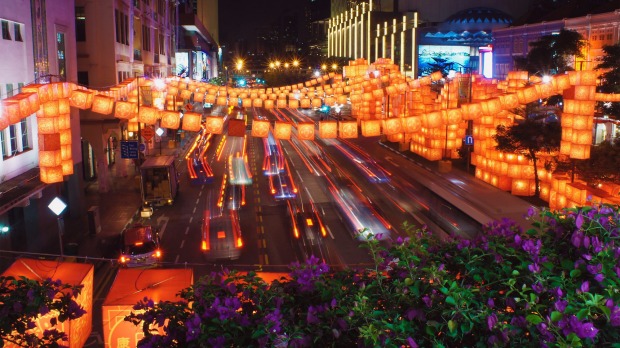
You have to be fleet of foot in Singapore in August as you walk along the street trying not to step in plates of food, clusters of incense or piles of burning paper that litter the streets. This is not litter, it is the remnants of Hungry Ghost Month. Think of it as a Singaporean take on Halloween, when the spirits of deceased relatives are believed to wander the earth looking for offerings. Locals burn paper money – and even paper cars, houses and iPads! – to appease these restless spirits.
There are many altars around the streets and the public housing estates but there are also a lot of ghosts so some people just put plates of suckling pig and oranges on the footpath and road, and be very careful not to take any of the offerings home – or the ghost will move in with you.
One of the best places to observe Hungry Ghost Month is the Lian Shan Shuang Lin Monastery in the heartlands area of Toa Payoh. The history of this site dates back to 1858, long before the tiny island was self-governing and it is the biggest Buddhist temple on the island. But the Hungry Ghost tradition dates back even further to the tradition of ancestor worship in Ming Dynasty China.
Singapore may be 50 years young this year, but it has cultural traditions that stretch back hundreds of years and Chinese ancestor worship is just one of these events.
In November, the Indian festival of Deepavali literally lights up the area known as Little India. This "festival of light" sees the pokey alleyways around this sub-continental enclave pack with henna tattooists, stalls selling strings of lights and also plastic packets that expand and explode when stepped on, resulting in a big bang. Singaporeans also head to Little India to see the decorative street lights strung across the street, and to visit the temples like the Sri Veeramakaliamman Temple that dates back to 1855.
With a huge Malay population, Ramadan, which dates back as far as the 7th century, is one of the biggest events on the Singaporean calendar. There are two main spots to be: around the Malay Quarter in Kampong Glam where the focal point in the Sultan Mosque and the predominantly Muslim area of Geylang Serai where a month-long bazaar pops up along the main street selling, clothes and, when the sun sets, take away meals for hungry devotees.
Chinese opera fans can attend a show at Chinese Theatre Circle headquartered in the heart of Chinatown. Shows travel the full length of the island and the CTC has been putting on performances of this ancient art form since its inception in 1981.
The Singapore River has a history that is far older and richer than the 50 years of self rule. In 1819, Sir Stamford Raffles set foot on the island to lay claim to it for the British and his huge white statue is now a selfie-magnet at the Raffles Landing Site on the river, but the statue is a copy. The original was a smaller bronze affair that was first unveiled on the landing site in 1887, it has since been moved to stand outside the Victoria Memorial Hall at Empress Place.
After your selfie you can grab a wooden boat and head upriver to Robertson Quay, here you will find a quieter version of busy Clarke Quay. Pull up a chair in Bar Bar Black Sheep, a modern bar and hawker combo that serves izakaya, Indian and western bites. It's not venerable, but it is a great place to raise a glass to Singapore's 50 sovereign years, and all the history that came before it.
www.yoursingapore.com
Major airlines Singapore Airlines (www.singaporeair.com), Qantas (www.qantas.com), Emirates (www.emirates.com) and British Airways (www.britishairways.com) all fly to Singapore from Melbourne and Sydney. For low-cost carriers, Scoot (www.flyscoot.com) flies from Sydney to Singapore (and starts out of Melbourne in November) and Jetstar (jetstar.com) flies from Melbourne to Singapore.
The Ramada Singapore at Zhongshan Park is just a short walk from Toa Payoh, this Ramada also has a wine bar on the peaceful Zhongshan Park. Rooms from S$260 a night including breakfast. See ramada.com. Stay right on the doorstep of Little India in the Village Hotel Albert Court, 180 Albert Street, see www.stayfareast.com. Double from S$185 ($183) and the hotel is also close to shopping at Bugis Junction.
Visit Bar Bar Black Sheep at 86 Robertson Quay, bbbs.com.sg, as well as four other islandwide operations which boast a very rare all-day happy hour.
Visit some of the island's oldest temple at Lian Shan Shuang Lin Monastery, 184 Jalan Toa Payoh; shuanglin.sg, Sri Veeramakaliamman Temple, 141 Serangoon Rd; see www.sriveeramakaliamman.com or the Sultan Mosque in Kampong Glam, 3 Muscat St; see www.sultanmosque.sg. Bazaar Ramadhan pops up at Sims Ave and Geylang Road (nearest MRT station, Paya Lebar), but the Geylang Serai hawker is always a great place to find Muslim food. Raffles Landing Site is at Downtown Core, Singapore while the Victorian Memorial Hall is at 9 Empress Pl; see www.nac.gov.sg.